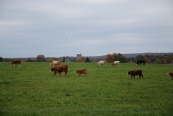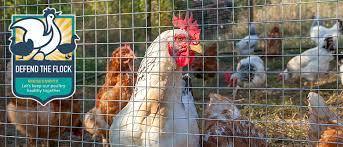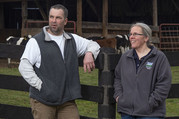
The U.S. Department of Agriculture (USDA) encourages producers and landowners to enroll in the Grassland Conservation Reserve Program (CRP) starting next week through May 13, 2022. Grassland CRP provides a unique opportunity for farmers, ranchers, and agricultural landowners to keep land in agricultural production and supplement their income while improving their soils and permanent grass cover. The program had its highest enrollment in history in 2021 and is part of the Biden-Harris Administration’s broader effort to equip producers with the tools they need to help address climate change and invest in the long-term health of our natural resources.
Grassland CRP is a federally funded voluntary working lands program. Through the program, USDA’s Farm Service Agency (FSA) provides annual rental payments to landowners to maintain and conserve grasslands while allowing producers to graze, hay, and produce seed on that land. Maintaining the existing permanent cover provides several benefits, including reducing erosion, providing wildlife habitat and migration corridors, and capturing and maintaining carbon in the soil and cover.
FSA provides participants with annual rental payments and cost-share assistance. The annual rental rate varies by county with a national minimum rental rate of $13 per acre for this signup. Contract duration is 10 or 15 years.
Broadening Reach of Program
As part of the Agency’s Justice40 efforts, producers and landowners who are historically underserved, including beginning farmers and military veterans, will receive 10 additional ranking points to enhance their offers.
Additionally, USDA is working to broaden the scope and reach of Grassland CRP by leveraging the Conservation Reserve Enhancement Program (CREP) to engage historically underserved communities. CREP is a partnership program that enables states, Tribal governments, non-profit, and private entities to partner with FSA to implement CRP practices and address high priority conservation and environmental objectives. Interested entities are encouraged to contact FSA.
More Information on CRP
Landowners and producers interested in Grassland CRP should contact their local USDA Service Center to learn more or to apply for the program before the May 13 deadline. Additionally, fact sheets and other resources are available at fsa.usda.gov/crp.
Signed into law in 1985, CRP is one of the largest voluntary private-lands conservation programs in the United States. The working lands signup announced today demonstrates how much it has evolved from the original program that was primarily intended to control soil erosion and only had the option to take enrolled land out of production. The program has expanded over the years and now supports a greater variety of conservation and wildlife benefits, along with the associated economic benefits.
|

To date, USDA’s National Veterinary Services Laboratories has confirmed the presence of Highly Pathogenic Avian Influenza (HPAI) in commercial and backyard flocks in several states including New York. Avian influenza viruses are classified as either “low pathogenic (LPAI)” or “highly pathogenic (HPAI)” based on their genetic features and the severity of the disease they cause in poultry. Caused by an influenza type A virus, HPAI can infect poultry (such as chickens, turkeys, pheasants, quail, domestic ducks, geese, and guinea fowl) and wild birds (especially waterfowl).
The clinical signs of birds affected with all forms of Avian Influenza may show one or more of the following:
- Sudden death without clinical signs
- Decreased water consumption up to 72 hours before other clinical signs
- Lack of energy and appetite
- Decreased egg production
- Soft–shelled or misshapen eggs
- Swelling of the head, eyelids, comb, wattles, and hocks
- Purple discoloration of the wattles, combs, and legs
- Nasal discharge
- Coughing, sneezing
- Lack of coordination
- Diarrhea
In addition to the disease infecting domestic birds, it is important to know that wild birds can also be infected and show no signs of illness. They can carry the disease to new areas when migrating, potentially exposing domestic poultry to the virus. The APHIS’ wild bird surveillance program provides an early warning system for the introduction and distribution of avian influenza viruses of concern in the United States, allowing APHIS and the poultry industry to take timely and rapid action.
With the recent detections of avian influenza in wild birds and domestic poultry in the United States, bird owners should review their biosecurity practices and stay vigilant to protect poultry and pet birds from transmission of this disease. The following bio-safety guidelines are effective methods for safeguarding commercial operations and smaller flocks:
- Backyard flock owners should practice strict biosecurity, including preventing birds from exposure and/or co-mingling with wild birds and other types of poultry.
- Shower, change clothes, and clean and disinfect footwear before entering your poultry housing areas.
- Respiratory protection such as a medical facemask would also be important and remember to always wear clean clothes when encountering healthy domestic birds.
- Carefully follow safe entry and exit procedures into your flock’s clean area.
- Reduce the attractiveness for wild birds to stop at your place by cleaning up litter and spilled feed around poultry housing areas.
- If you have free range guinea fowl and waterfowl, consider bringing them into coops or flight pens under nets to prevent interaction of domesticated poultry with wild birds and their droppings.
- It is best to restrict visitors from interacting with your birds currently.
- Do not touch sick or dead wildlife and keep them away from domestic poultry
- Try not to handle sick or deceased domestic birds (if you must, use proper personal protective equipment to minimize direct contact and cautiously disinfect anything that comes into contact with the deceased and or sick bird).
As part of the existing USDA Avian Influenza response plans, Federal and State partners as well as industry are responding quickly and decisively to these outbreaks by following these five basic steps:
-
Quarantine – restricting movement of poultry and poultry-moving equipment into and out of the control area;
-
Eradicate – depopulate the affected flock(s);
-
Monitor region – testing wild and domestic birds in a broad area around the quarantine area;
-
Disinfect – kills the virus in the affected flock locations; and
-
Test – confirming that the poultry farm is AI virus-free.
Sick or deceased domestic birds should be reported to your local veterinarian. Positive domestic cases are handled by APHIS and its partners. States that have confirmed cases of Avian Influenza should work closely with USDA-APHIS on surveillance, reporting and control efforts. Disposal methods will be evaluated on a case-by-case basis depending on a variety of factors, including the size of the flock, space requirements, associated costs, local conditions, and applicable laws/regulations.
The United States has the strongest Avian Influenza surveillance program in the world, where we actively look for the disease and provide fair market value compensation to affected producers to encourage reporting.
If you do not raise domestic birds or have a poultry operation but you encounter sick or dead wild birds, please use bio-safety measures, and report your findings through USDA’s toll-free number at 1-866-536-7593.
According to the Centers for Disease Control, this strain of Avian Influenza is a low risk to the public. While the transmission rate from animals to humans is low, it is a zoonotic disease, meaning it can be shared between species. To learn more about Avian Influenza and to remain up to date on the latest related news and information, you can visit the USDA APHIS webpage.
|

Farmers can use USDA farm ownership microloans to buy and improve property. These microloans are especially helpful to beginning or underserved farmers, U.S. veterans looking for a career in farming, and those who have small and mid-sized farming operations.
Microloans have helped farmers and ranchers with operating costs, such as feed, fertilizer, tools, fencing, equipment, and living expenses since 2013.
Microloans can also help with farmland and building purchases and soil and water conservation improvements. FSA designed the expanded program to simplify the application process, expand eligibility requirements and expedite smaller real estate loans to help farmers strengthen their operations. Microloans provide up to $50,000 to qualified producers and can be issued to the applicant directly from the USDA Farm Service Agency (FSA).
For more information on FSA farm loan programs, contact your local USDA Service Center or visit fsa.usda.gov.
|

The National Environmental Policy Act (NEPA) requires Federal agencies to consider all potential environmental impacts for federally funded projects before the project is approved.
For all Farm Service Agency (FSA) programs, an environmental review must be completed before actions are approved, such as site preparation or ground disturbance. These programs include, but are not limited to, the Emergency Conservation Program (ECP), Farm Storage Facility Loan (FSFL) program and farm loans. If project implementation begins before FSA has completed an environmental review, the request will be denied. Although there are exceptions regarding the Stafford Act and emergencies, it’s important to wait until you receive written approval of your project proposal before starting any actions.
Applications cannot be approved until FSA has copies of all permits and plans. Contact your local FSA office early in your planning process to determine what level of environmental review is required for your program application so that it can be completed timely.
|

USDA’s National Agricultural Statistics Service (NASS) conducts hundreds of surveys every year and prepares reports covering virtually every aspect of U.S. agriculture.
If you receive a survey questionnaire, please respond quickly and online if possible.
The results of the surveys help determine the structure of USDA farm programs, such as soil rental rates for the Conservation Reserve Program and prices and yields used for the Agriculture Risk Coverage and Price Loss Coverage programs. This county-level data is critical for USDA farm payment determinations. Survey responses also help associations, businesses and policymakers advocate for their industry and help educate others on the importance of agriculture.
NASS safeguards the privacy of all respondents and publishes only aggregate data, ensuring that no individual operation or producer can be identified.
NASS data is available online at nass.usda.gov/Publications and through the searchable Quick Stats database. Watch a video on how NASS data is used at youtube.com/watch?v=m-4zjnh26io&feature=youtu.be.
|

Farm Service Agency (FSA) is committed to providing our farm loan borrowers the tools necessary to be successful. FSA staff will provide guidance and counsel from the loan application process through the borrower’s graduation to commercial credit. While it is FSA’s commitment to advise borrowers as they identify goals and evaluate progress, it is crucial for borrowers to communicate with their farm loan staff when changes occur. It is the borrower’s responsibility to alert FSA to any of the following:
- Any proposed or significant changes in the farming operation
- Any significant changes to family income or expenses
- The development of problem situations
- Any losses or proposed significant changes in security
If a farm loan borrower can’t make payments to suppliers, other creditors, or FSA on time, contact your farm loan staff immediately to discuss loan servicing options.
For more information on FSA farm loan programs, contact your local USDA Service Center or visit fsa.usda.gov.
|
The Value-Added Producer Grant (VAPG) program administered by USDA’s Rural Development helps agricultural producers enter into value-added activities related to the processing and marketing of new products. The goals of this program are to generate new products, create and expand marketing opportunities, and increase producer income.
You may receive priority if you are a beginning farmer or rancher, a socially-disadvantaged farmer or rancher, a small or medium-sized farm or ranch structured as a family farm, a farmer or rancher cooperative or are proposing a mid-tier value chain.
Grants are awarded through a national competition. Each fiscal year, applications are requested through a notice published in the Federal Register and through an announcement posted on Grants.gov. Paper Applications must be postmarked by May 2, 2022. Applications are permitted via Grants.gov and must be received by 11:59 p.m. Eastern time on April 25, 2022.
Independent producers, agricultural producer groups, farmer- or rancher-cooperatives, and majority-controlled producer-based business ventures, as defined in the program regulation, are eligible to apply for this program.
Grant and matching funds can be used for planning activities or for working capital expenses related to producing and marketing a value-added agricultural product. Examples of planning activities include conducting feasibility studies and developing business plans for processing and marketing the proposed value-added product.
Examples of working capital expenses include:
- Processing costs.
- Marketing and advertising expenses.
- Some inventory and salary expenses.
Please read the Federal Register notice for the details on how to apply. Applicants should put together the required information at least a month before the application deadline. The extra time allows collection of other required materials such letters of commitment or support from other organizations, a work plan and budget, and other information. Copies of required forms are available from your nearest Rural Development Office. See the Forms & Resources tab for optional forms that may assist you in developing your application.
If you have questions, please contact Gary Pereira, the NY lead for this program, at gary.pereira@usda.gov or 315-530-3433 .

The Farm Service Agency’s (FSA) Farm Storage Facility Loan (FSFL) program provides low-interest financing to help you build or upgrade storage facilities and to purchase portable (new or used) structures, equipment and storage and handling trucks.
Eligible commodities include corn, grain sorghum, soybeans, oats, wheat, barley, minor oilseeds harvested as whole grain, pulse crops (lentils, chickpeas and dry peas), hay, honey, renewable biomass, fruits, nuts and vegetables for cold storage facilities, floriculture, hops, maple sap and syrup, rye, milk, cheese, butter, yogurt, meat and poultry (unprocessed), eggs, and aquaculture (excluding systems that maintain live animals through uptake and discharge of water). Qualified facilities include grain bins, hay barns and cold storage facilities for eligible commodities.
Loans up to $50,000 can be secured by a promissory note/security agreement, loans between $50,000 and $100,000 may require additional security, and loans exceeding $100,000 require additional security.
You do not need to demonstrate the lack of commercial credit availability to apply. The loans are designed to assist a diverse range of farming operations, including small and mid-sized businesses, new farmers, operations supplying local food and farmers markets, non-traditional farm products, and underserved producers.
For more information, contact your local USDA Service Center or visit fsa.usda.gov/pricesupport.
|
The U.S. Department of Agriculture (USDA) is announcing the signup period for its Clean Lakes, Estuaries, And Rivers initiative (CLEAR30) — a nationwide opportunity for certain landowners and agricultural producers currently implementing water quality practices through the Conservation Reserve Program (CRP) to enroll in 30-year contracts, extending the lifespan and strengthening the benefits of important water quality practices on their land.
Producers may apply for CLEAR30, a voluntary, incentive-based conservation program, from April 1, 2022, through Aug. 5, 2022.
Cropland and certain pastureland currently enrolled in Continuous CRP or the Conservation Reserve Enhancement Program (CREP) and dedicated to an eligible water quality practice such as riparian buffers, contour strips, grass waterways or wetland restoration may be eligible if their contracts are expiring by September 30, 2022.
CLEAR30 contracts will be effective beginning Oct. 1, 2022. These long-term contracts ensure that conservation practices remain in place for 30 years, which improves water quality through reducing sediment and nutrient runoff and helping prevent algal blooms. Conservation in riparian areas also provides important carbon sequestration benefits. Traditional CRP contracts run from 10 to 15 years.
About CLEAR30
CLEAR30 was established in the 2018 Farm Bill to better address water quality concerns. Originally, CLEAR30 was only available in the Great Lakes and Chesapeake Bay watersheds; in 2021, FSA made CLEAR30 available to agricultural producers and landowners nationwide, and participation grew nearly seven-fold from 2020 to 2021.
Annual rental payments for landowners who enroll in CLEAR30 will be equal to the current Continuous CRP annual payment rate plus a 20 percent water quality incentive payment and an annual rental rate adjustment of 27.5 percent.
How to Sign Up
To sign up for CLEAR30, landowners and producers should contact their local USDA Service Center by Aug. 5, 2022. Contact information can be found at farmers.gov/service-locator. Additionally, fact sheets and other resources are available at fsa.usda.gov/crp.
More Information
CLEAR30 is an option available through CRP, which is one of the largest voluntary private-lands conservation programs in the United States. CRP was originally intended to primarily control soil erosion and stabilize commodity prices by taking environmentally sensitive lands out of production. The program has evolved over the years, providing numerous conservation and economic benefits. In addition to CLEAR30, signups are also open for Continuous CRP and Grassland CRP.
The Agricultural Foreign Investment Disclosure Act (AFIDA) requires all foreign owners of U.S. agricultural land to report their holdings to the Secretary of Agriculture. Foreign persons who have purchased or sold agricultural land in the county are required to report the transaction to FSA within 90 days of the closing. Failure to submit the AFIDA form could result in civil penalties of up to 25 percent of the fair market value of the property. County government offices, realtors, attorneys and others involved in real estate transactions are reminded to notify foreign investors of these reporting requirements. The data gained from these disclosures is used in the preparation of periodic reports to the President and Congress concerning the effect of such holdings upon family farms and rural communities. Click here for more information on AFIDA.
|